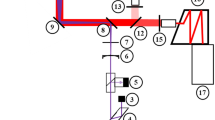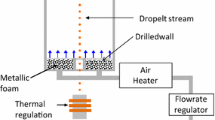Abstract
This paper describes the development of a laser induced fluorescence (LIF) technique to quantify the thickness and spatial distribution of transient liquid fuel films formed as a result of spray–wall interaction. The LIF technique relies on the principle that upon excitation by laser radiation the intensity of the fluorescent signal from a tracer like 3-pentanone is proportional to the film thickness. A binary solution of 10% (v/v) of 3-pentanone in iso-octane is used as a test fuel with a Nd:YAG laser as the excitation light source (utilising the fourth harmonic at wavelength 266 nm) and an intensified CCD camera is used to record the results as fluorescent images. The propagation of the excitation laser beam through the optical piston is carefully controlled by total internal reflection so that only the fuel film is excited and not the airborne droplets above the film, which had been previously shown to induce significant error. Other known sources of error are also carefully minimised. Calibrated temporally resolved benchmark results of a transient spray from a gasoline direct injector impinging on a flat quartz crown under atmospheric conditions are presented, with observations and discussion of the transient development of the fuel film. The calibrated measurements are consistent with previous studies of this event and demonstrate the applicability of the technique particularly for appraisal of CFD predictions. The potential utilisation of the technique under typical elevated ambient conditions is commented upon.











Similar content being viewed by others
References
Cho H, Min K (2003) Measurement of liquid fuel film distribution on the cylinder liner of a spark ignition engine using the laser-induced fluorescence technique. Meas Sci Technol 14:975–982
Fansler TD, Drake MC (2006) “Designer diagnostics” for developing direct-injection gasoline engines. Second international conference on optical and laser diagnostics (ICOLAD 2005). J Phys Conf Ser 45:1–17
Fujikawa T, Hattori Y, Koike M, Akihama K, Kobayashi T, Matsushita S (1999) Quantitative 2D fuel distribution measurements in a direct-injection gasoline engine using a laser-induced fluorescence technique. JSME Int J 42(4):760–767
Kay PJ (2006) Characterising thermofluid spray dynamics for energy-efficient automotive engines. PhD Thesis, Cardiff University
Kay PJ, Bowen PJ, Gold M, Sapsford S (2005) Impingement studies of G-DI sprays at atmospheric and elevated ambient densities. Annual conference on liquid atomisation and spray systems, North and South America Irvine, California
Kay PJ, Bowen PJ, Gold M, Sapsford S (2006) Development of a 2D quantitative LIF technique towards measurement of transient liquid fuel films. 10th international congress on liquid atomisation and spray systems, Kyoto, Japan
Kull E, Wiltafsky G, Stolz W, Min KD, Holder E (1997) Two-dimensional visualization of liquid Layers on transparent walls. Opt Lett 22:645–647
Le Coz JF, Baritaud T (1994) Application of laser induced fluorescence for measuring the thickness of evaporating gasoline liquid films. In: Proceeding of the 7th symposium on developments in laser techniques and applications to fluid mechanics. Lisbon, pp 113–131
Li J, Matthews RD, Stanglmaier RH, Roberts CE, Anderson RW (1999) Further Experiments on the effects of in-cylinder wall wetting on Hc emission from direct-injection gasoline engines. SAE Technical Paper Series: 1999-01-3661
Martinez RD, Buitrago AA, Howell NW, Hearn CH (1992) The near absorption spectra of several aliphatic aldehydes and ketones at 300 K. Atmos Environ 26(5):785–792
Schulz C, Sick V (2005) Tracer-LIF diagnostics: quantitative measurement of fuel concentration, temperature and fuel/air ratio in practical combustion systems. Prog Energy Combust Sci 31:75–121
Seitzman JM, Hanson RK (1993) Instrumentation for flows with combustion. A.M.K.P. Taylor Academic Press, pp 405–466
Stanglmaier RH, Li J, Matthews RD (1999) The effect of in-cylinder wall wetting location on the HC emissions from SI engines. SAE Publications: 1999-01-0502
Yang J, Melton LA (2000) Fluorescence-based method designed for quantitative measurement of fuel film thickness during cold start of engines. Appl Spectrosc 54(4):565–574
Zhao H, Ladommatos N (1998) Optical diagnostics for In-Cylinder mixture formation measurements in IC engines. Prog Energy Combust Sci 24:297–336
Zhao F, Lai MC, Harrington DL (1999) Automotive spark-ignited direct-injection gasoline engines. Prog Energy Combust Sci 25:437–562
Author information
Authors and Affiliations
Corresponding author
Rights and permissions
About this article
Cite this article
Alonso, M., Kay, P.J., Bowen, P.J. et al. A laser induced fluorescence technique for quantifying transient liquid fuel films utilising total internal reflection. Exp Fluids 48, 133–142 (2010). https://doi.org/10.1007/s00348-009-0720-8
Received:
Revised:
Accepted:
Published:
Issue Date:
DOI: https://doi.org/10.1007/s00348-009-0720-8




